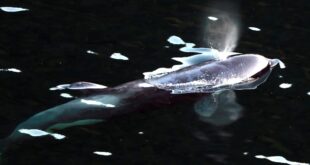Eclipses offer a unique opportunity for scientists to study how sunlight affects the ionosphere.

While viewers across North America will be looking up at the spectacle of two different kinds of eclipses in the next year, scientists investigating their effects will have their attention directed a little closer to Earth.
We are fortunate to have a moon that is just the right size and just the right distance to appear exactly the same size as it passes between the sun and our planet, giving us the spectacular phenomena of solar eclipses. Well, almost exactly.
Since the moon orbits the Earth in a slight oval-like path, it is sometimes farther away and appears smaller, which produces what’s known as an annular eclipse.
There’s one coming up on Oct. 14 that will be partially visible from western Canada as it crosses over the U.S. During an annular eclipse, the moon does not completely cover the sun so we see a luminous ring in the sky.

Since part of the sun is always visible during an annular eclipse, there is no point where you can look at it with the naked eye.
However, the total eclipse on April 4, which cuts through Southern Ontario, parts of Quebec and New Brunswick, offers a wonderful opportunity for a few minutes during totality, when the moon completely covers the sun, to see the beautiful silvery corona, or outer atmosphere, of our star.
But while skywatchers will be looking up, a group of scientists at NASA are taking a high altitude approach to viewing the eclipses. Instruments on three sounding rockets will be fired 70 to 325 kilometres up into the ionosphere before, during and after the moon’s shadow passes over the Earth.
The mission is called Atmospheric Perturbations around the Eclipse Path, or APEP, which is the name of an ancient Egyptian serpent deity who pursued Ra, the sun god and occasionally attempted to consume him, causing eclipses.
The scientists are interested in the effect a sudden drop in sunlight can have on our own upper atmosphere, or ionosphere, that extends from 90 to 500 kilometres into space. This is a region above Earth that’s occupied by many satellites including the International Space Station.

At that altitude, the ultraviolet light from the sun cause atoms and molecules in the upper atmosphere to become electrically charged, from sunrise until sunset.
The ionosphere is also where the northern lights are formed and it can be used to bounce radio signals around the world, a favourite pastime of HAM radio operators. It is still sometimes used for communications during emergencies when electronic systems fail.
Solar disturbances can even interrupt satellite communication in the ionosphere and if it becomes too inflated by solar activity, it can cause low orbiting satellites to come down sooner than expected.
Since the thickness of this charged layer of atmosphere varies with activity from the sun, eclipses that temporarily block or reduce the sunlight reaching our planet provide a rare opportunity for scientists to probe this region.
During the 2017 total eclipse that also crossed theU.S. and was partially visible from Canada, waves were detected in the ionosphere that crossed the continent, like the wake around a boat passing through a lake. Now the scientists want to study those waves in much finer detail.
Instruments will measure electric and magnetic fields, temperature and density on the way up and back down on suborbital flights. The first launches will be from the White Sands Missile Range in New Mexico, then the same instruments will be launched in April from Wallops Flight Facility in Virginia.

At the same time, instruments on the ground and balloons will study the ionosphere and weather conditions to make the most complete vertical measurement of the atmosphere before and after an eclipse.
Eclipses are free spectacles provided by the sun and moon, and from a scientific perspective, they’re interesting every way you look at them.
ABOUT THE AUTHOR
Bob McDonald is the host of CBC Radio’s award-winning weekly science program, Quirks & Quarks. He is also a science commentator for CBC News Network and CBC-TV’s The National. He has received 12 honorary degrees and is an Officer of the Order of Canada.
*****
Credit belongs to : www.cbc.ca
 Atin Ito First Filipino Community Newspaper in Ontario
Atin Ito First Filipino Community Newspaper in Ontario







